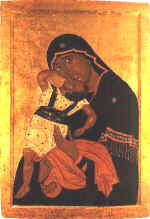|
In 1985, during the excavations of the walls of a late-Roman/early-Byzantine fortress at Vinica, archaeologists discovered the foundations of several secular buildings and, their debris, discovered a true archaeological treasure: a number of unique icons of the early Christianity period worked in ceramics and thought to date from the late 4th century. These icons are unlike any others previously known, duplicated by using a mould and standardised painting. The figures are roughly 30 or 31 centimeters high, roughly 28 centimeters wide, and 4 centimeters thick. Inscriptions and signatures are written in Latin, with beautifully modelled letters, and the saints are presented without auras.
The most frequent illustrations are those of Archangel Michael with his wings folded and that of St. Theodore on a horse, dressed in a uniform of a Byzantine soldier. The cross of Emperor Constantine is presented on a number of icons, as well as symbolic animals and floral motifs. Distinguished for their high artistic qualities are the icons "St. Christopher and St. George," "Daniel in the Lions' Den," and "The Fruits of the Promised Land." Excavations have recently been renewed following a three-year pause, and may yet uncover more examples of these intriguing icons.
  The high development of fresco-painting had its own reflection on the works created in the field of icon painting. The oldest icons discovered in Macedonia — more specifically, in Ohrid — date from the 11th and early 12th centuries. These include the icons "St. Vasilij and St. Nicholas," "The Forty Martyrs," "The Communion of the Apostles," and the Holy Virgin of "Annunciation with Archangel." Whatever the extent of influence by the Constantinople school on these icons, it is useless to deny their original and high artistic accomplishments. The high development of fresco-painting had its own reflection on the works created in the field of icon painting. The oldest icons discovered in Macedonia — more specifically, in Ohrid — date from the 11th and early 12th centuries. These include the icons "St. Vasilij and St. Nicholas," "The Forty Martyrs," "The Communion of the Apostles," and the Holy Virgin of "Annunciation with Archangel." Whatever the extent of influence by the Constantinople school on these icons, it is useless to deny their original and high artistic accomplishments.
In the sphere of icon creation, the 13th century abounds in such a great wealth and variety of style that each icon virtually represents a unique style. Art historians stress, for example, that "Mother of God Hodegetria" and "St. Barbara," both dating from the first half of the 13th century, are characterised by their refined sculpture, while "Jesus Christ Almighty on the Throne" unites the elements of the archaic and the contemporary, opening a new direction for artistic expression. Deacon John the painter, in his "St. George" expresses an entirely original conception of the painted sculpture. Experts point to the procession icon "Mother of God Hodegetria with the Crucifixion," dating from the second half of the 13th century as belonging to the emerging 13th century school of sculpture.
The same applies to the icons by Michail Astrappa and Eutychius, "Deisis," "The Resurrection of Christ," and "The Evangelist Matthew," created at the end of the 13th century. In the early 14th century, the two masters of the paintbrush introduced elements of the Palaeologi Renaissance to icon-painting. Their new conception was accepted by many other icon-painters who worked in Macedonia at that time, resulting in a series of icons ("The Faithless Thomas," "The Baptising of Christ," "Holy Virgin Episcepsis," "The Resurrection," and "Mother of God Hodegetria" in the Church of St. Nikita near Skopje), of undeniable contribution to the general wealth of Macedonian icon-painting. These icons were mainly created by unknown icon-painters. However, in the 14th century the brothers Metropolitan John Zograf and Hieromonk Macarius were also active and their icons "Deisis," "Holy Virgin Pelagonitisa," and "Jesus Christ the Saviour and Lifegiver" represent the highest level of icon-painting in Macedonia. But the 14th century was also marked by the Ottoman conquest of Macedonia, triggering a sharp decline in the quality of fresco-painting and icon-painting. A hundred years later, these two arts began to develop again, but under entirely new conditions. Still, fresco-painters worked as icon-painters as well, as in the former periods.
By the middle of the 15th century, Zograph Dimitrija of Leunovo (near Mavrovo) and his associate Jovan created icons in the iconostasis of Toplica Monastery near Bitola. In the early 16th century, Hieromonk Gerasim (creator of the "St. John the Theologian and Prochorus") and Hieromonk Kalinik (creator of "Deisis" in the monastery of the village of Slepce, near Demir Hisar) continued the new tradition of renewed icon-painting, based on the rich traditions of the Ohrid painting school.
From Macedonia Yesterday and Today by Jovan Pavlovski & Misel Pavlovski (www.mian.com.mk)
Translated by: Zaharija Pavlovska |